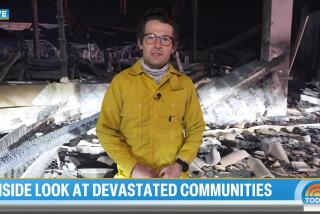A Room With a View in Baghdad
- Share via
Welcome to the age of fiber optics, satellite transmission and portable video cams--not to mention smart bombs, cruise missiles and computer guidance. Technology reigns supreme and affects many aspects of our life, and our death, for better and for worse. In the news-gathering business, as has been especially obvious these past few days, it has made things better.
The world first heard of the United States air attack on key military and infrastructure sites near Baghdad from a series of dramatic telephone conversations from a Baghdad hotel. On assignment from CNN--the superb, round-the-clock news network--correspondents Bernard Shaw, Peter Arnett and John Holliman were in their room in the Al Rashid when the first wave of U.S. air sorties arrived over Baghdad. Their vivid, sometimes breathless, descriptions--against the background of bombs going off practically every few seconds--brought the war into many living rooms and offices.
Such sterling reportage is not entirely new. Edward R. Murrow’s memorable eyewitness commentary during the Nazi bombing of London was in a technological sense little different, for in effect what the CNN trio provided until Thursday, when Iraqi officials suddenly cut the phone link, was nothing more than terrific radio. Some videotape pictures went out later via satellite transmission but the first instant eyewitness communication was all audio and no video.
That scarcely detracts from CNN’s achievement. Murrow was in friendly territory; the CNN trio was not. But the network’s commitment to, and experience with, round-the-clock news operations had those three correspondents in enemy territory, in position to provide its considerable worldwide TV audience, which included top Iraqi as well as U.S. officials, with the news as it was happening.
Instant television has now become a useful art in diplomacy, and for a time Baghdad officials no doubt had their own reason for being so cooperative with CNN. Other networks were to break in on their regularly scheduled programming with their own news reports--some of them excellent accounts from correspondents on the scene in Baghdad and others parts of the Persian Gulf. But by then CNN had a clear news lead on its competitors.
The technology of modern television is impressive. The video footage from the embattled Persian Gulf is compelling viewing. But technology by itself is cold, lifeless, useless stuff unless it has trained and talented human beings who have the ability--and in this instance the courage--to use it well. Those early CNN reports made this living-room war a memory that will remain in many viewers’ minds for years to come.
More to Read
The biggest entertainment stories
Get our big stories about Hollywood, film, television, music, arts, culture and more right in your inbox as soon as they publish.
You may occasionally receive promotional content from the Los Angeles Times.










